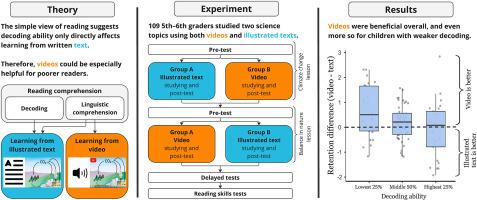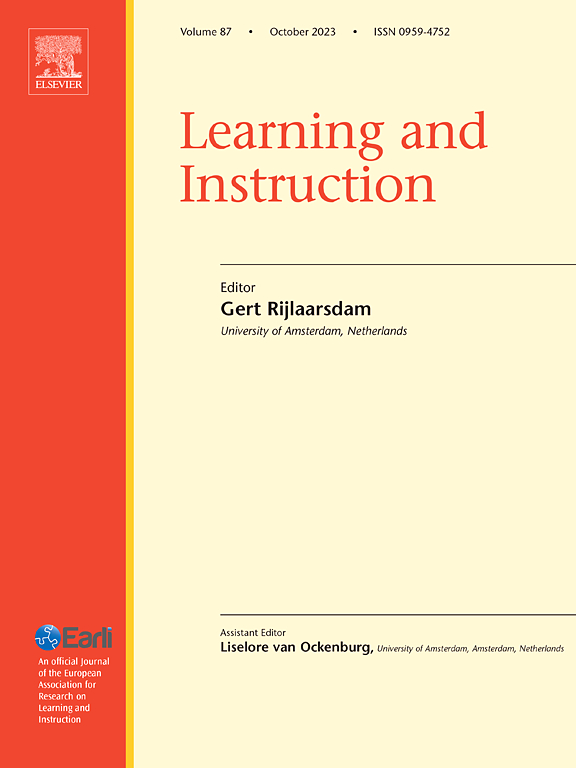从图文和视频中学习的“简单”观点
IF 4.9
1区 教育学
Q1 EDUCATION & EDUCATIONAL RESEARCH
引用次数: 0
摘要
最近经合组织地区儿童阅读技能的下降对传统的基于文本的学习提出了挑战。与此同时,教师越来越多地在小学教学中使用视频。尽管取得了这些进展,但关于儿童阅读技能如何影响小学课堂上的视频学习与图文学习的研究有限。目的探讨五、六年级学生在视频学习与图文学习中解码能力和阅读理解的作用。目的是确定这些因素对学习结果和认知负荷的影响程度。样本为三所公立小学5-6年级的109名儿童。方法在一项受试者内实验中,参与者研究了两个科学主题的插图文本和视频。他们的表现是通过前、后和延迟测试来衡量的。混合效应模型评估了学习方式和阅读技能对学习结果和认知负荷的影响。结果儿童在视频学习中表现明显优于图文学习,表现出较高的延迟记忆和较低的认知负荷。从材料中检索和转移没有差异。解码能力和阅读理解正向预测学习结果,并与模式相互作用:视频的记忆效果在阅读技能较低的儿童中比在阅读技能较高的儿童中更为明显。结论视频教学对大多数不同阅读水平的儿童,尤其是阅读能力较弱的儿童都是有益的。这表明,将视频纳入小学科学教学支持与阅读能力较弱相关的多种学习需求。本文章由计算机程序翻译,如有差异,请以英文原文为准。

The “simple” view of learning from illustrated texts and videos
Background
The recent decline in children's reading skills in OECD regions poses challenges for traditional text-based learning. At the same time, teachers increasingly use videos in primary instruction. Despite these developments, limited research exists on how children's reading skills influence learning from videos versus illustrated texts in primary school classrooms.
Aims
This study investigates the roles of decoding ability and reading comprehension in learning from videos versus illustrated texts among fifth and sixth graders. It aims to determine to what degree these factors influence learning outcomes and cognitive load.
Sample
109 children from grades 5–6 across three public primary schools.
Methods
In a within-subjects experiment, participants studied both illustrated texts and videos on two science topics. Their performance was measured through pre-, post-, and delayed tests. Mixed-effects models assessed the effect of modality and reading skills on learning outcomes and cognitive load.
Results
The children performed significantly better when learning from videos compared to illustrated texts, demonstrating higher delayed retention and lower cognitive load. There was no difference in retrieval from materials or transfer. Decoding ability and reading comprehension positively predicted learning outcomes and interacted with modality: the retention benefits of videos were more pronounced in children with lower reading skills than in those with higher reading skills.
Conclusions
The results indicate that videos are beneficial to most children across reading skill levels, especially those with weaker reading skills. This suggests that incorporating videos into primary school science instruction supports diverse learning needs associated with weaker reading skills.
求助全文
通过发布文献求助,成功后即可免费获取论文全文。
去求助
来源期刊

Learning and Instruction
Multiple-
CiteScore
11.30
自引率
4.80%
发文量
109
期刊介绍:
As an international, multi-disciplinary, peer-refereed journal, Learning and Instruction provides a platform for the publication of the most advanced scientific research in the areas of learning, development, instruction and teaching. The journal welcomes original empirical investigations. The papers may represent a variety of theoretical perspectives and different methodological approaches. They may refer to any age level, from infants to adults and to a diversity of learning and instructional settings, from laboratory experiments to field studies. The major criteria in the review and the selection process concern the significance of the contribution to the area of learning and instruction, and the rigor of the study.
 求助内容:
求助内容: 应助结果提醒方式:
应助结果提醒方式:


